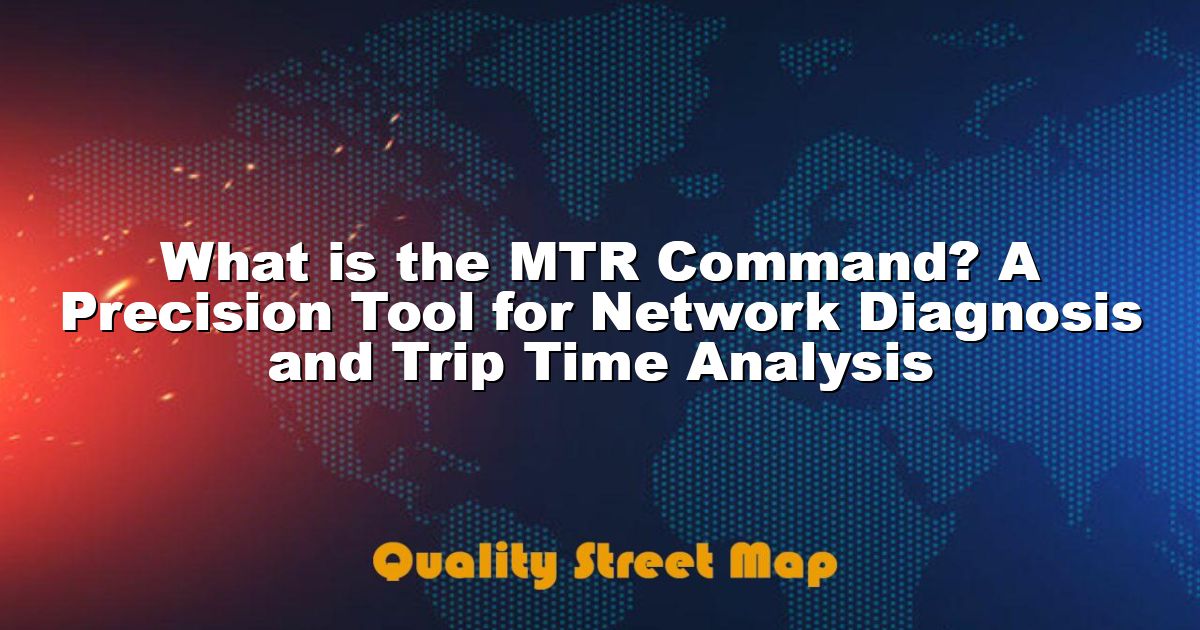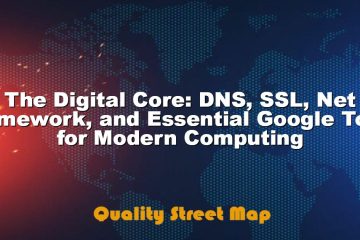What is the MTR Command? A Precision Tool for Network Diagnosis and Trip Time Analysis

Understanding What Is The MTR Command
The MTR command is an invaluable tool for network administrators and IT professionals. It stands out by combining the functionality of both the traceroute and ping commands to provide a more comprehensive analysis of network paths. By continuously sending packets from the source to the destination, the MTR command gathers data that help in diagnosing network abnormalities. Users gain visibility into round trip times and identify potential bottlenecks affecting network performance. This continuous monitoring makes the MTR command a preferred choice for real-time network diagnostics.
In terms of utility, the MTR command offers several advantages over traditional network diagnostic tools. While traceroute provides a snapshot of the path data packets take, MTR offers a continuous assessment that helps in gauging the current state of the network. This tool’s capability to evaluate performance metrics such as latency and packet loss over time makes it indispensable for network troubleshooting. By pinpointing the exact hop where issues arise, it simplifies the troubleshooting process, allowing for faster resolution times and efficient network management.
The MTR command is not just a tool; it’s a real-time network analysis partner that evolves with modern IT needs.
Key Benefits Of MTR Command
- Provides real-time network diagnosis and path analysis
- Combines traceroute and ping functionalities for comprehensive results
- Helps identify specific network hops causing latency and packet loss
- Facilitates proactive troubleshooting and network management
- Simplifies the task of analyzing network performance over time
- Assists in maintaining optimal network health and efficiency
The MTR command’s unique approach to network diagnostics ensures administrators have comprehensive insights into their network infrastructure. This tool’s ability to deliver precise and actionable data, such as hop-by-hop latency and packet loss rates, is crucial for maintaining network stability. With its detailed reports, stakeholders can make informed decisions, proactively address issues, and ensure that the network operates at peak performance. Its real-time feedback mechanism not only aids in swift troubleshooting but also helps in future network planning and capacity building.
How MTR Command Enhances Network Diagnosis
In the realm of network diagnostics, What is most sought after is a tool that provides comprehensive insights effortlessly. That’s where the MTR command comes into play. MTR, short for My Traceroute, blends the capabilities of traceroute with ping, offering a real-time display of route paths and network performance. As packets traverse from source to destination, MTR collects vital data on packet loss and latency, which are pivotal for diagnosing network issues. This seamless blend of traceroute and ping offers network engineers the precision they need to track problematic nodes along a route.
To fully harness the potential of the MTR command, it’s crucial to understand the correct execution process. Here’s a structured guide on Steps To Execute MTR Command Properly:
- Ensure the MTR tool is installed on your system. Use the appropriate package manager for your OS, such as APT for Debian/Ubuntu or Yum for CentOS.
- Open the terminal and enter
mtrfollowed by the target hostname or IP address. - Select desired options, such as the interval between packets or the number of packets to send, by using command flags.
- Analyze the continuous output to visualize real-time network performance data.
- Consider saving output to a text file for in-depth analysis and record-keeping. This can be done by appending a ‘>’ followed by the file name.
- Adjust packet parameters based on initial findings to refine diagnostic results.
An in-depth examination of MTR’s output reveals much about its value in network diagnostics. By default, MTR presents results in a tabular format that updates continuously as it gathers more data. Columns typically represent crucial parameters like the IP of each hop, RTT (Round Trip Time) statistics including best, worst, and average, along with a standard deviation for clarity. These metrics provide a revealing glance at the network’s health, identifying bottlenecks and inconsistencies with a clear layout.
Detailed Analysis Of MTR Output
Understanding the data presented in MTR’s output is vital for effective network diagnosis. Each hop in the table represents a gateway that packets encounter en route to their final destination. Observing consistent packet loss at any hop indicates a potential issue that may need further examination. In contrast, fluctuations in Round Trip Time can suggest latency problems. Network professionals often leverage this information to optimize performance and avert connectivity issues. Without question, the MTR command’s detail orientation offers a granular view that other tools rarely achieve.
Practical Applications Of MTR
The utility of the MTR command extends across various practical applications. Network administrators use it not only for troubleshooting connectivity issues but also for proactive monitoring of network health. Whether it’s checking the reliability of a connection to a web server or diagnosing intermittent slowdowns, MTR proves indispensable. By dissecting network paths over time, MTR assists in strategizing comprehensive improvements, ensuring robust performance and continuity of service. MTR is the microscope through which network flaws are examined, lending itself as an essential tool in a network administrator’s toolkit.
Actionable Insights Gained From MTR Trip Time Analysis
Analyzing trip times with the MTR command provides a wealth of actionable insights, crucial for network optimization. By aggregating data over a period, it helps in identifying latency issues and inconsistencies in connection paths. This analysis is particularly beneficial for network administrators who need to maintain seamless connectivity. It uncovers patterns in network delays that can be correlated with server performance, helping in pinpointing whether the issues stem from bandwidth bottlenecks or routing inefficiencies.
Moreover, the insights derived from this analysis can lead to more precise adjustments and configurations in network settings. By assessing the variation in trip times, professionals can determine the stability and reliability of network routes. This is crucial for ensuring that user applications operate without hitches. The MTR command’s ability to provide real-time network statistics differentiates it as a precision tool essential for fine-tuning network performance. This capability offers unparalleled advantages in maintaining optimal network efficiency.
Consistently analyzing trip times helps anticipate network congestion before it becomes a significant issue, thereby preserving the quality of service for end-users.
Best Practices For MTR Usage
- Run MTR tests during different times of the day to gather comprehensive data.
- Compare results over weekly or monthly periods to track changes.
- Use MTR in combination with other diagnostic tools for enhanced accuracy.
- Focus on both average and maximum times in your analysis.
- Configure alerts for significant deviations in trip times.
- Regularly update network configurations based on MTR insights.
- Incorporate MTR findings into routine maintenance schedules.
Network engineers rely on these insights to maintain robust systems that support business operations. The gathered data serves as a guide for future infrastructure investments and strategic decisions. By understanding what is causing fluctuations, businesses can prioritize technical resources effectively and ensure that their networks are resilient against unexpected issues. In turn, this promotes a proactive culture of management, where potential problems are identified and resolved before impacting users.
In conclusion, leveraging MTR trip time analysis provides actionable insights that are paramount in today’s fast-paced digital environments. Through strategic and informed use of the MTR command, network performance can be optimized, ensuring both efficiency and reliability. This results in improved user satisfaction and a reinforcement of the organization’s technological infrastructure, which is integral in maintaining competitive advantage. Network administrators should continuously refine their approach to trip time analysis, as it is a critical component of comprehensive network management.















